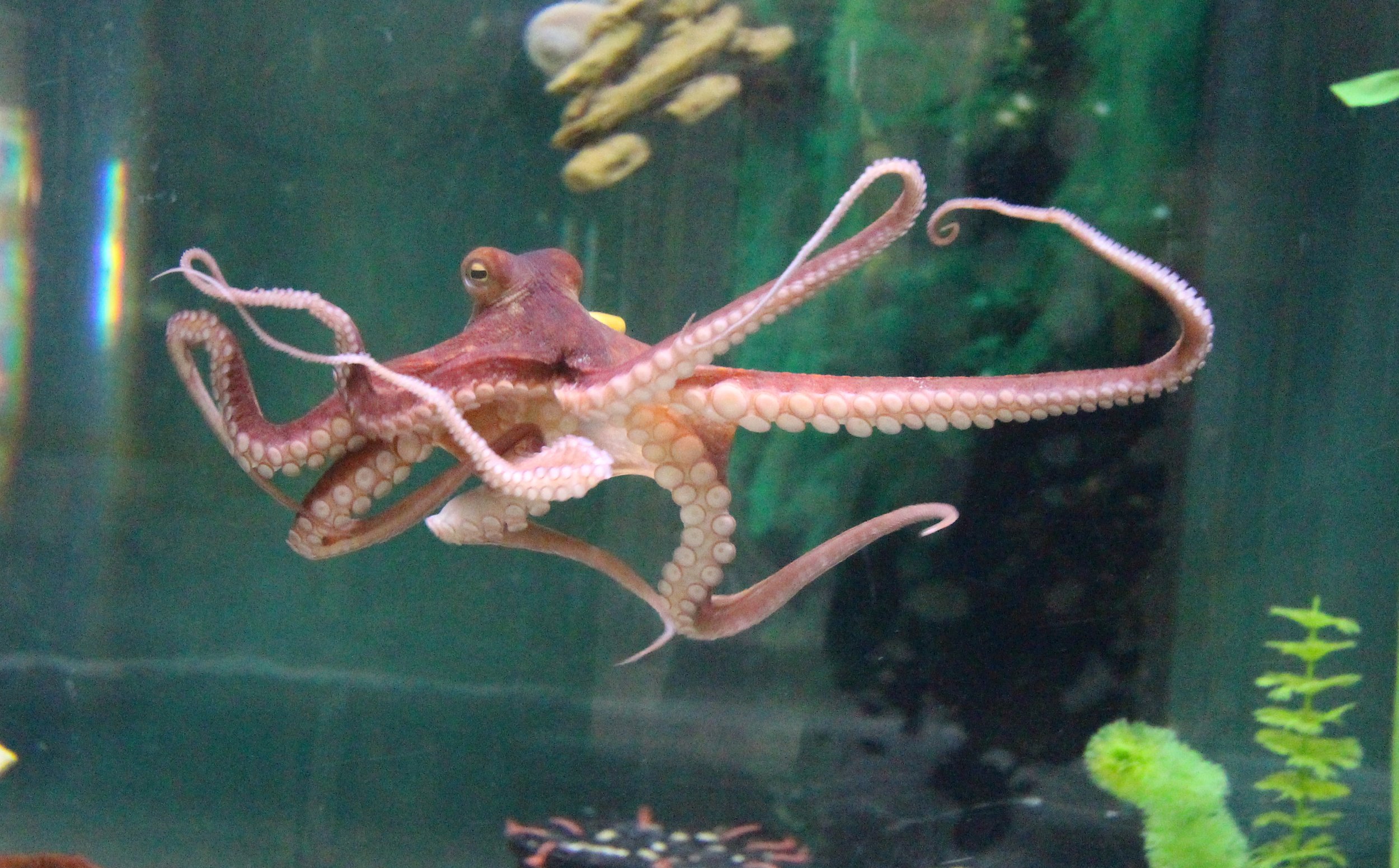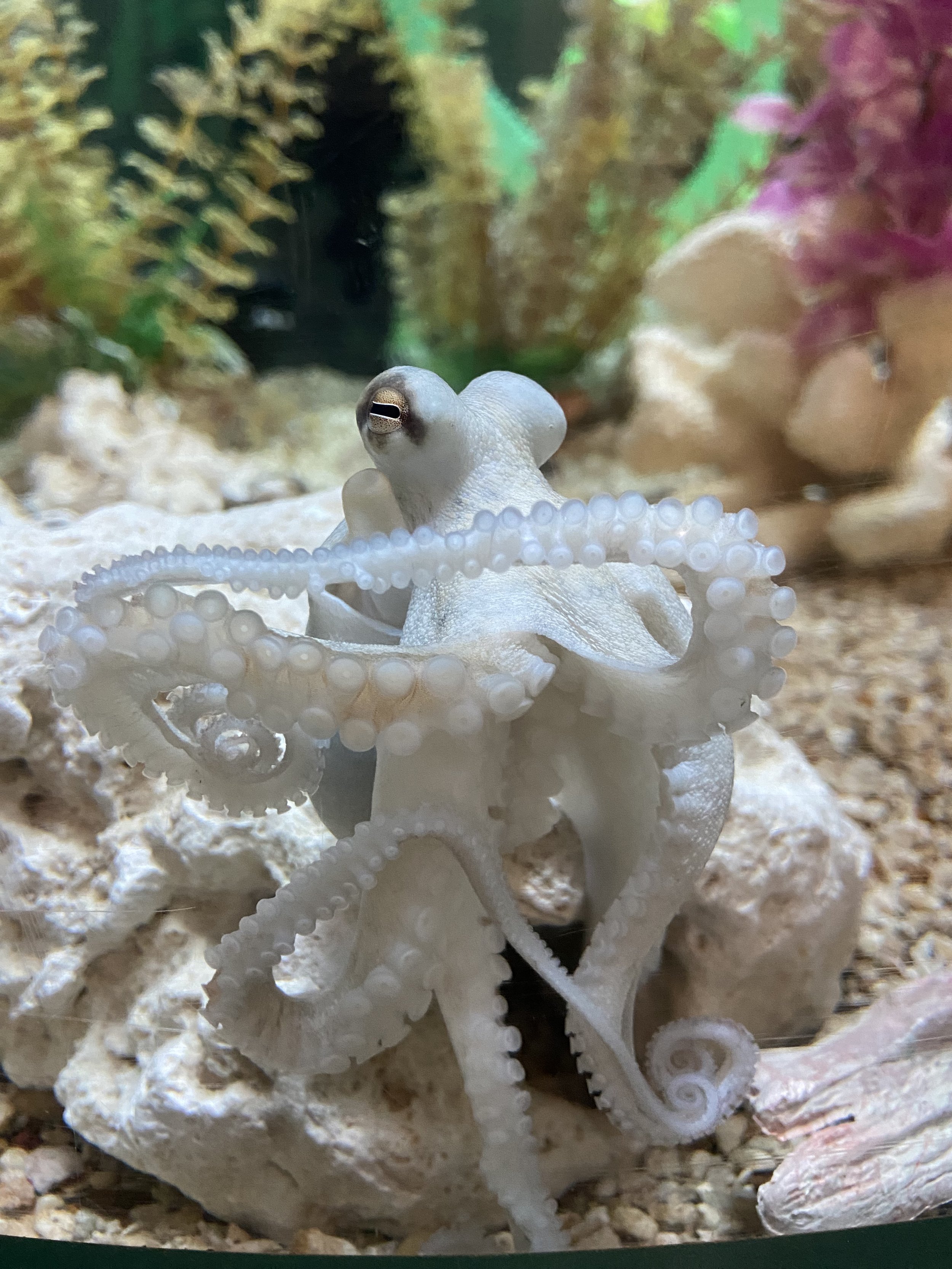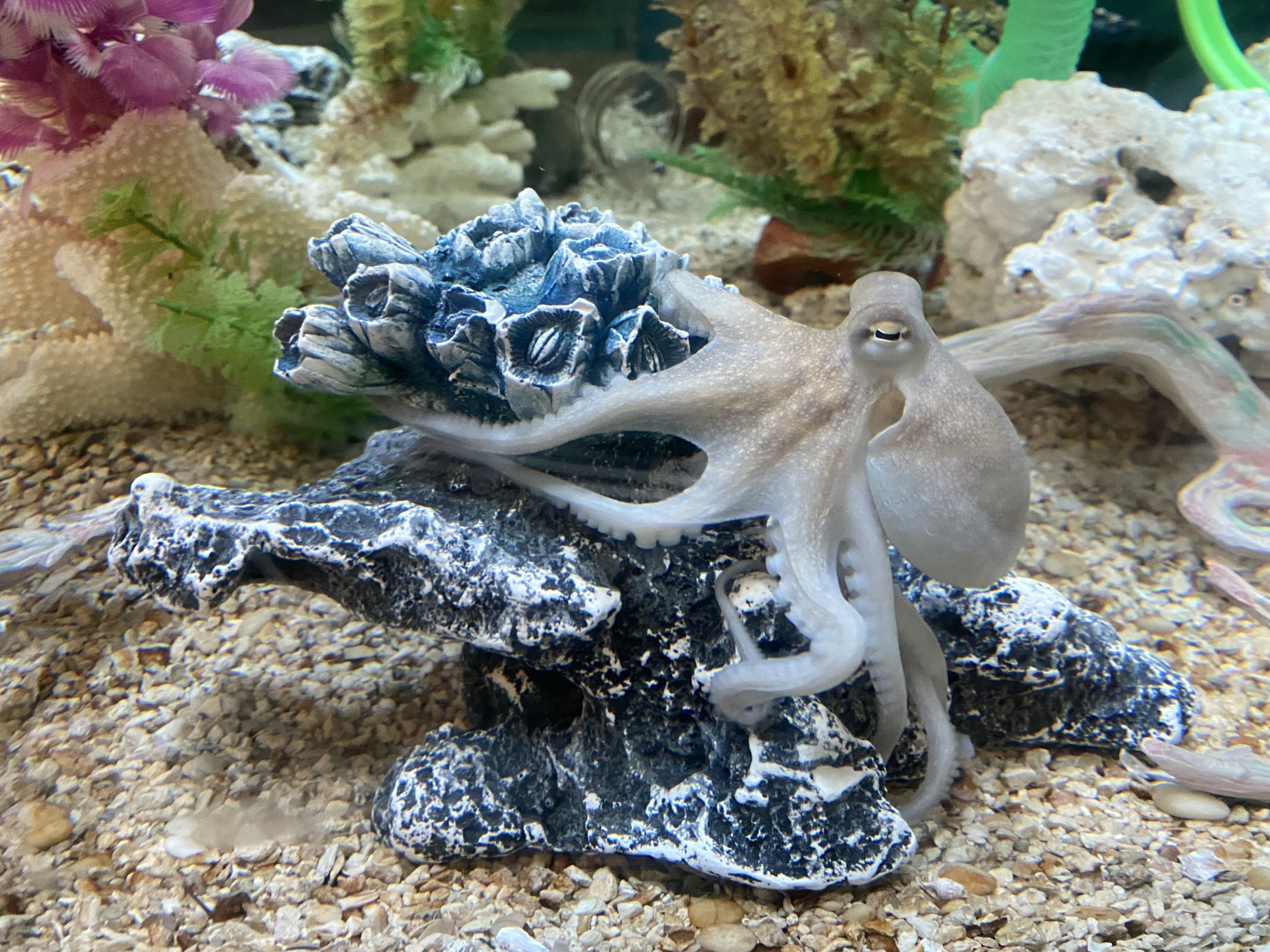Eight (Arms) is Enough: Meet The Wetlands Institute’s New Resident
What has eight arms, can change colors at will, and is both a master puzzle-solver and expert escape artist? The common octopus, of course! Octopus vulgaris – as the species is known in scientific circles – is one of the more fascinating residents of our local waters. Despite its name, people rarely see octopuses in their native environment, and most know very little about these incredible creatures: “Common” refers to their distribution rather than your chances of encountering one.
It might surprise you that we have common octopuses living nearby, but it is a cosmopolitan species, found throughout the world’s oceans in tropical and temperate zones – including right here in coastal New Jersey. About the only place you won’t find one is in the Earth’s exceptionally frigid polar and subpolar waters (and who can blame them?). Octopuses are remarkable, and the newest resident in our Secrets of the Salt Marsh aquarium provides a unique opportunity for visitors to watch one in action and learn all about these amazing creatures.
Octopus mythology and symbolism are abundant through history. The most familiar is the Kraken – a legendary sea monster that was the bane of seafarers around the world, dragging ships and their crews down to the inky depths. The Kraken has been a mainstay in popular culture for years and continues to appear in literature and movies. It is a fixture in Scandinavian and Norse mythology, but its roots are far older, harkening back to the ancient Greek creature Scylla. Scylla was a six-headed beast who lived across a narrow strait from the maelstrom Charybdis; together they posed an inescapable maritime hazard, forcing sailors passing through the strait to make a perilous choice. To this day, being “caught between Scylla and Charybdis” implies having to choose between the lesser of two evils. And you can thank Greek mythology if you’ve ever been “between a rock and a hard place.”
Fortunately, the common octopus is far too small to be a sea monster. It varies in length from about
12 inches to 3 feet (other species not found locally can be much larger) – much smaller than the ship-swallowing beasts of myth. Ours at The Wetlands Institute is about a foot long, and still growing. All that growth is fueled by a strict seafood diet. In the wild, they prefer to feast on crabs, clams, and mussels, but will eat virtually anything they can catch. (We feed ours a mix of local seafood items collected right out of the marsh here at the institute, which he consumes with gusto!) They crush shells with their hard “beaks,” and catch prey in powerful webbed arms lined with double rows of suction-cup-like suckers. These suckers have super-sticky surfaces to help grasp prey; in order to keep them sticky, octopuses shed the lining of their suckers periodically – similarly to how sharks shed teeth. Once they have captured their prey, they can paralyze it with a nerve poison present in their saliva.
In addition to their signature arms, octopuses are equipped with a host of fascinating features. The most obvious is their bulbous head (or mantel), but they also have three hearts; their blood is copper-based, not iron; and they absorb oxygen through their skin. And octopuses can force water through their mantels to produce jet propulsion to get around – or to squirt an unsuspecting aquarist. (Ask ours how she knows this!)
Water isn’t the only substance an octopus can squirt, though. These creatures are adept at protecting themselves from predators, and have a remarkable suite of defenses. When threatened, they can squirt a cloud of ink into the water. This ink contains a substance that dulls a predator’s senses of vision and smell, helping to confuse it while the octopus escapes under cover of inky darkness. If the going gets really tough, an octopus can sacrifice an arm to a predator and grow it back later!
Their preferred method of defense, however, is hiding – and they have a few special tricks to do this. Very little of an octopus’ body is solid, allowing octopuses to squeeze into exceedingly small spaces – making them hard to see if they don’t want to be noticed. They also collect shells and other objects to build fortresses around their lairs – a behavior that ours practices often. (He’s actually a bit of a hoarder, and frequently tries to drag his toys down to the depths as well. They float, so he’s still working on that!)
Antics of The Wetlands Institute resident octopus. They can change color, squeeze into small spaces - like jars - and use their tentacles to explore.
The pièce de résistance, though, is their ability to disappear. Octopuses are masters of disguise and can change the color and even texture of their skin to blend in with their surroundings and hide in plain sight. They use a network of tiny, color-changing cells called chromatophores that line their entire body just below the surface of the skin. Octopuses can constrict or relax these special cells, causing varying levels of pigment to appear. Specialized muscles in their skin also allow them to change skin texture. This combination of abilities allows octopuses to shift colors and patterns to match their environment – and they can pull off these tricks rapidly, so that as they move over the bottom, they can instantly change to match the background. It’s pretty amazing to watch how dramatically they can change and how quickly they are able to do so.
Behind all of these defenses is a highly developed neurological system. Octopuses are believed to be the most intelligent of all invertebrates – that is, animals without backbones. They have large, doughnut-shaped brains as well as a network of neurons that are distributed throughout their arms. In fact, an octopus contains about two-thirds of its neurons in its tentacles, not its brain. These neurons function as little sub-brains, allowing each arm to taste, touch, smell, and act independently – no input from the main brain required! Scientists have documented their ability to determine the size and shape of objects, remember patterns, navigate mazes, and solve problems. They play, they can open containers, and they are the only invertebrate we know of that uses tools – a trait typically reserved for higher-order mammals. All this intelligence can get them into all kinds of mischief. As mentioned above, our resident octopus enjoys spraying unsuspecting keepers with water, and octopuses in aquarium settings have been known to escape and grab a midnight snack from neighboring tanks.
Our resident octopus is no exception: He is a fast learner and can open a variety of containers to get his meal of mussels, fish, or crab – and even unscrew lids! He has his favorite toys and plays with them throughout the day. (He’s particularly fond of tubes, which he loves to pull apart.) He also enjoys interacting with us here at the institute, and is curious about new people. Come on out and spend some time getting to know him. You’ll be surprised at what you discover, and you might leave having made a new friend.






